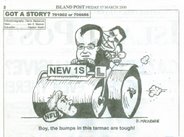RET or Sunday ferries
The reason? That the Board didn't want to tie the hands of the Scottish Government (the owners of CalMac) who are considering which ferry route will be trialled for Road Equivalent Tariff, and who are supposed to be taking a decision in the next month.
As I have said, to try to determine the impact of RET you shouldn't change any of the other parameters, so a Sunday ferry becomes highly unlikely or the statistics will become difficult to interpret.
From a practical point or view, the Stornoway-Ullapool route is almost at full capacity, so the effect of RET will be even more difficult to measure unless you add more services or you start to measure those who are turned away.
Unless that is the plan - using a full ferry to demonstrate the marginal impact that RET has on ferry traffic.
My forecast - that the CalMac Board throw the decision on Sunday sailings back to the Government, as a variation under the newly approved tenders, and get the Minister to carry the can for (non)-implementation.





1 comment:
Agree with your theory but not your conclusion. The RET pilot will be as much an exercise in what the government can afford in long term subsidy as pure scientific research. People are making assumptions about routes and fare reductions but in reality it will be a balance between measurable outputs, immediate benefits and affordability, all within an intruigingly political balance. There may be local political pressure to include all WI routes but with a fixed budget the fare reductions will inevitably be less - not being cynical (honest) but RET formula will be picked to suit the projected loss of revenue. In this scenario Ministers (not of the cloth) would be mad not to go for Sunday services as the no brainer for extra capacity and revenue. The alternative more scientific but politically riskier approach would be bigger fare reductions but only on one or two routes where there is capacity, less displacement potential and where the downstream benefits are easier to estimate. This one would appeal to the economists and in that sense you are right about creating extra capacity. This approach could be tried on SY-ULL freight service and perhaps the Uist/Barra route. I predict option 1 with Sunday sailings included - but that might just be wishful thinking.
Post a Comment